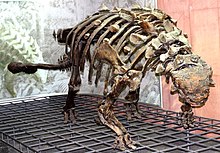Ankylosauridae
| Ankylosaurids Temporal range: Early Cretaceous - Late Cretaceous,
| |
|---|---|

| |
| Mounted skeleton of Euoplocephalus tutus, Senckenberg Museum | |
| Scientific classification | |
| Domain: | Eukaryota |
| Kingdom: | Animalia |
| Phylum: | Chordata |
| Clade: | Dinosauria |
| Clade: | †Ornithischia |
| Clade: | †Thyreophora |
| Clade: | †Ankylosauria |
| Clade: | †Euankylosauria |
| Family: | †Ankylosauridae Brown, 1908 |
| Type species | |
| †Ankylosaurus magniventris Brown, 1908
| |
| Subfamilies | |
|
†Ankylosaurinae Brown, 1908 | |
| Synonyms | |
|
Syrmosauridae Maleev, 1952 | |
An ankylosaurid is a member of the armored dinosaur family Ankylosauridae that appeared 122 million years ago (along with another family of ankylosaurs, the Nodosauridae) and became extinct 66 million years ago during the Cretaceous–Paleogene extinction event. Ankylosaurids have been found in western North America, Europe and East Asia, though good specimens are rare; most are known only from bone fragments.
Features

The heavy armour, forming a veritable shell on the backs of ankylosaurids and their clubbed tails, makes them look superficially similar to the mammalian glyptodonts (and to a lesser degree to the giant meiolaniid turtles of Australia).
Their heavily armoured heads formed a toothless beak at the front (comparable to modern birds), though the sides of the mouth and the lower jaw did bear small teeth, deeply inset from the jaw. Among all the ornithischians, the endocranial anatomy of ankylosaurs is the most poorly known.[1]
Armor
Ankylosaurids usually had a thick armour plating of fused bone, often interspersed with a variety of spikes and lumps. Ankylosaurids were so heavily armored that some advanced species even had armoured eyelids.
Tail
Many ankylosaurids also had an enlarged mass of bone forming a "club" on the end of their tails, made of two enlarged bone lumps. This tail club has traditionally been used to separate ankylosaurids from their close relatives the nodosaurids, although the many primitive ankylosaurids ("shamosaurines", and even basal ankylosaurines) also lacked bony tail clubs.
Classification
Taxonomy

The polacanthids are sometimes included as a subfamily of ankylosaurids, as Polacanthinae. However, phylogenetic analyses since 2000 have shown the polacanthids to form either a natural group apart from the ankylosaurids, or to be an unnatural grouping of primitive ankylosaurs.[2]
The following uses the ranks from Benton 2004.[3] The following taxonomy follows Thompson et al., 2011 unless otherwise noted.[4]
- Family Ankylosauridae
- Aletopelta[5]
- Cedarpelta
- Gobisaurus
- Liaoningosaurus
- Minmi
- Shamosaurus
- Subfamily Ankylosaurinae
Phylogeny

Ankylosauridae was first named by Brown in 1908 and defined by him as "all ankylosaurs more closely related to Ankylosaurus than to Panoplosaurus". Sereno, 2005 redefined it as: The most inclusive clade containing Ankylosaurus magniventris but not Panoplosaurus mirus.[7] Ankylosaurinae was first named by Nopcsa in 1918 and defined by Sereno, 1998 as "all ankylosaurids more closely related to Ankylosaurus than to Shamosaurus". Sereno, 2005 redefined it as: The most inclusive clade containing Ankylosaurus magniventris but not Gargoyleosaurus parkpinorum, Minmi paravertebra, or Shamosaurus scutatus. The cladogram below follows the most resolved topology from a 2011 analysis by paleontologists Richard S. Thompson, Jolyon C. Parish, Susannah C. R. Maidment and Paul M. Barrett.[4]
| Ankylosauridae | |
Timeline

Timeline of genera

References
- ^ Coombs W. (1978). "An endocranial cast of Euoplocephalus (Reptilia, Ornithischia)". Palaeontographia, Abteilung A 161: 176–82.
- ^ Hayashi, S., Carpenter, K., Scheyer, T.M., Watabe, M. and Suzuki. D. (2010). "Function and evolution of ankylosaur dermal armor." Acta Palaeontologica Polonica, 55(2): 213-228. doi:10.4202/app.2009.0103
- ^ [1]
- ^ a b Richard S. Thompson, Jolyon C. Parish, Susannah C. R. Maidment and Paul M. Barrett (2011). "Phylogeny of the ankylosaurian dinosaurs (Ornithischia: Thyreophora)". Journal of Systematic Palaeontology. 10 (2): 301–312. doi:10.1080/14772019.2011.569091.
{{cite journal}}: CS1 maint: multiple names: authors list (link) - ^ "Carlsbad Ankylosaur (Ornithischia, Ankylosauria): An Ankylosaurid and Not a Nodosaurid, Chapter 12 of Carpenter, ed". The Armored Dinosaurs, Indiana University Press, Bloomington & Indianapolis, Indiana: 239–260. 2001.
{{cite journal}}: Unknown parameter|authors=ignored (help) - ^ "A new ankylosaurid from the Upper Cretaceous Kirtland Formation, San Juan Basin, with comments on the diversity of ankylosaurids in New Mexico" (PDF). Fossil Record 3. New Mexico Museum of Natural History and Science, Bulletin. 53: 169–178. 2011.
{{cite journal}}: Unknown parameter|authors=ignored (help) - ^ [2]
- Dinosaurs and other Prehistoric Creatures, edited by Ingrid Cranfield (2000), Salamander books, pg. 250-257.
- Carpenter K (2001). "Phylogenetic analysis of the Ankylosauria". In Carpenter, Kenneth(ed) (ed.). The Armored Dinosaurs. Indiana University Press. pp. 455–484. ISBN 0-253-33964-2.
{{cite book}}:|editor=has generic name (help)
- Kirkland, J. I. (1996). Biogeography of western North America's mid-Cretaceous faunas - losing European ties and the first great Asian-North American interchange. J. Vert. Paleontol. 16 (Suppl. to 3): 45A
External links
- Ankylosauridae
- Family Tree
- Ankylosauridae Tree of Life web project
